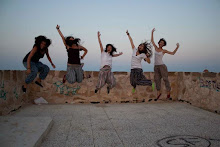"It is expected that once seen, an abandoned stone wall, the pong emerging from the ground or a great maple beside a river, that it would prove difficult to eliminate these from the mind, and thus, that there they would remain, spinning in one's imagination, waiting to see what can be done in concert with them. This is the magnet of such elements, of elements with a degree of attraction, such that we cannot forget them and that continue to reemerge in our mind." (Small Encounters, Juan Domingo Santos, 2000).
At the mercadillo, Festival de Moros y Cristiano, 1:30am outside a bar called La Boheme, I stood at the synapse where the structural met the social. From daily walks to extravagant fyre festivals, I began to gain a better understanding of the urban space nested within the coastal beach town of Guardamar. For six weeks, I observed the process by which the town compressed and decompressed, by which institutional parameters fluctuated depending on social gatherings. Rituals and festivals make up the very fabric of this town and very quickly, it became obvious how much power they had in altering and transforming the urban space in a very efficient way.
Alejandro calls the mercadillo a parasite that attaches and detaches itself to infrastructure in a cyclical fashion. Beginning at 7 in the morning, the market takes over intersection by intersection, establishes its network of services, and promotes its goods to meet the needs of the population. As a parasite, the mercadillo demonstrates a symbiotic relationship — the exchange of goods meets the needs vital to Guardamar’s community and population. The movement of cars is obstructed as tarps wrap around street lights and stalls and tents of all sorts consume every inch of the sidewalks. Once inside, all you hear is aggressive and loud fruit vendors; you see everything from shoes to ham of a lethal size to fruits and clothing; you smell the indelible smell of rotisserie chicken; you taste the sweat on your lips as even the tarps are not enough to shade you from the sweltering sun of a typical summer afternoon; you feel the wheels of the old grannies’ carts hit your ankles. Space is cramped and condensed. My sole source of navigation relies upon my memory of which fruit stand occupies which intersection, which ham truck would lead me down the road to the square, which end of the block had clothing stands and a smaller crowd, and which African stall was closest to Movellan which was a block away from the Pension. Like thresholds, stalls like the rotisserie chicken stand mark the borders of the market. By 2pm, metal posts are dismantled, tarps folded up, merchandise collected and boxed away, and everything is shoved into the back of a large truck that drives away into who knows where, ready to return for the following week at the same time and same place. Layer upon layer gradually stripped off the streets, people disperse, and crosswalks and sidewalks decompress and expand into its former mundane state. Within six hours, the visage of the streets has gone through its weekly routine cycle.
Like the mercadillo, the Festival de Moros y Cristianos repurposes mundane streets into a beautiful experiential space. White plastic chairs line the street and light decorations hang between light posts. Hundreds of people of all ages dressed in garments of the Moors and Christians march down the street with extravagant floats for four consecutive nights. The landscape of the town is transformed to accommodate this annual celebration of their history and heritage. The line of chairs shape and articulate the public space. It forms thresholds by delineating the boundaries for speculation.
In the evening and late into the night, tables spill out from the restaurant front onto the road. Motor vehicles are once again denied access onto the roads as families and friends fill up the tables. Grandmas pull out their plastic chairs and small couches onto the sidewalk to have a chat. From the residential neighborhoods to the beach boardwalk, people gather for ice cream or drinks. Restaurants close when people leave. Coming from a fast-paced, profit-oriented, capitalistic society, Spain's culture of creating community through leisure and festivities was shocking to me. Guardamar was a breath of fresh air.
What I learned from the program is that you can't understand architecture or urban space without understanding rituals, society, families, and people. Architecture is not just hollow structures or models. The language of architecture is one inextricable from humans. It is a combination of art and storytelling. Agnes Varda once said, "If you open people up, we'd find landscapes." When I first got off the bus, Guardamar was a little underwhelming. I wondered what Alejandro saw in Guardamar that prompted him to host a majority of the program in this small and seemingly average town. But it didn't take long for this town to become the little gem Juan Domingo Santos was talking about in the beginning quote. It has been a week since I left Guardamar yet the town still remains spinning and reemerging in my mind. Although I spent six weeks there, it feels as though I've only grazed the surface of the town. That being said, I don't think I know enough about Guardamar since I think it would require actually talking to its residents to get a comprehensive feel for the town. So maybe this is all just ignorant word vomit romanticizing/valorizing a place that holds immanent inequality. Either way, it was a drastic change from Oakland/Berkeley.
As I reminisce on time in Spain, my heart can't help but swell up with sentimentality!!! Knowing myself, the longer I stay at a place, the more attached I get. So really, with a two month program, I played mYSELF. Anyways, hasta luego Guardamar.
- janie
- janie
Mercadillo: https://youtu.be/4LFn6jJJcz8


No comments:
Post a Comment